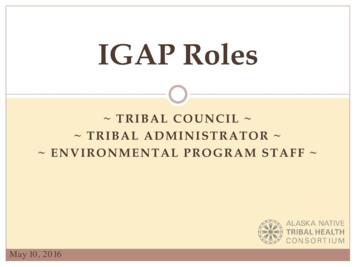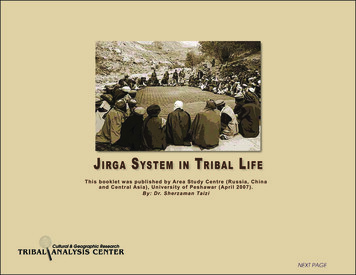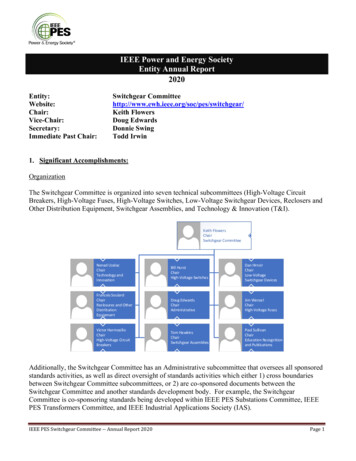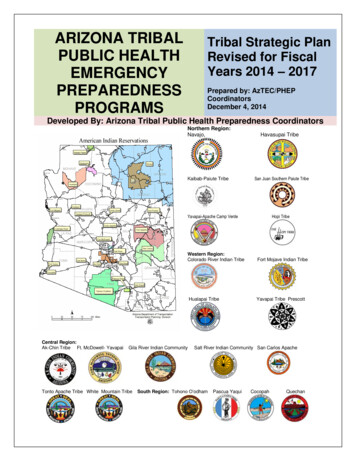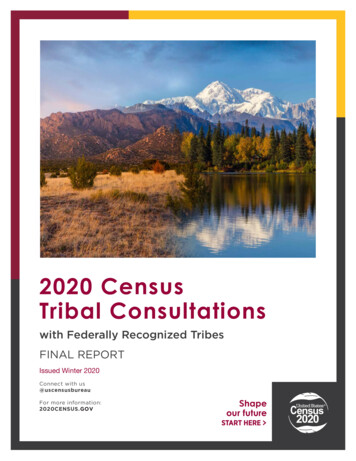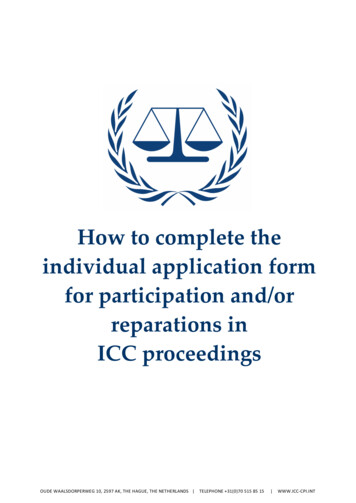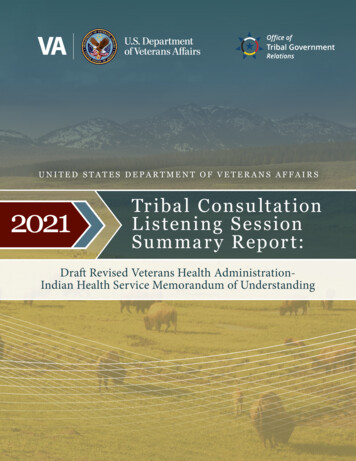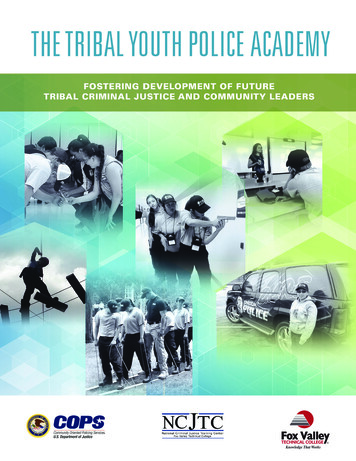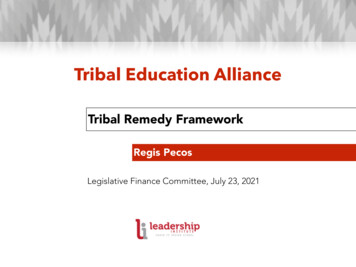
Transcription
U.S. Department of JusticeOffice of Justice ProgramsOffice for Victims of Crime
U.S. Department of JusticeOffice of Justice Programs810 Seventh Street NW.Washington, DC 20531Loretta E. LynchAttorney GeneralKarol V. MasonAssistant Attorney GeneralJoye E. FrostDirector, Office for Victims of CrimeOffice of Justice ProgramsBuilding Solutions Supporting Communities Advancing Justicewww.ojp.usdoj.govOffice for Victims of Crimewww.ovc.govNCJ 249582December 2016The mission of the Office for Victims of Crime is to enhance the Nation’s capacity to assist crimevictims and to provide leadership in changing attitudes, policies, and practices to promote justiceand healing for all victims of crime.The Office of Justice Programs (OJP) provides federal leadership in developing the Nation’s capacity to prevent and control crime, administer justice, and assistvictims. OJP has six components: the Bureau of Justice Assistance; the Bureau of Justice Statistics; the National Institute of Justice; the Office of Juvenile Justice andDelinquency Prevention; the Office for Victims of Crime; and the Office of Sex Offender Sentencing, Monitoring, Apprehending, Registering, and Tracking. Moreinformation about OJP can be found at www.ojp.gov.
ContentsProblem Statement. 1Oklahoma’s Tribal Communities . 1A Funding Opportunity Yields Results. 1High Rates of Victimization in American Indian Communities in Oklahoma. 2Outreach Plan and Project Implementation. 3Phase 1. 4Phase 2. 4Phase 3. 4Challenges Unique to Tribal Communities in Oklahoma. 4Limited Access to Services. 5Lack of Partnerships With the State of Oklahoma . 5Certification Limitations . 5Inexperience With the Grant Application Process . 5Strategies Implemented During the State-Tribal Crime Victim Liaison Outreach Project . 6Establishing Trust To Build Tribal Relationships . 6Conducting Ongoing Roundtables . 7Instituting Grant-Writing Workshops. 7Cultivating New Opportunities for Outreach . 8Results of the Project. 8Increase in Awareness of Available Victim Services Funding . 8Increase in Number of Grant Applications . 9Increase in Number of Funded Grant Applications. 9Increase in Funding for Direct Services . 9Recommendations.10Conclusion.11Appendix A – Map of Tribal Jurisdictions in Oklahoma. 12Appendix B – Form Letter . 13Office for Victims of Crime i
— PROBLEM STATEMENT —Victims in American Indian communities in Oklahomaexperience high rates of victimization, are underserved,and are unaware of available victim services.Oklahoma’s Tribal Communitiesmany victims in tribal communities throughoutOklahoma is home to the second largestsuch as victim compensation, victim assistance,American Indian population of any statecommunity programs, and victims’ rights.the state are not informed about resourcesin the Nation. Encompassing 38 federallyrecognized tribal headquarters and membersof 67 tribes, American Indians (AI) live in all77 counties in Oklahoma. The state’s tribalcommunities experience alarmingly high levelsA Funding OpportunityYields Resultsof victimization, including high rates of violentIn recognition of the high levels of violencecrime. The AI homicide rate from 2004 to 2007experienced by Oklahoma’s large AIwas, on average, 20 percent higher than the ratecommunities, coupled with the scarcity offor other races in Oklahoma.services provided to the state’s AI victims and1Compounding the issue of the high rate ofvictimization among Oklahoma’s AI populationis the limited access to direct services for thesevictims, who are often unaware of state andfederal resources available to them. As a result,the lack of available resources, the OklahomaDistrict Attorneys Council, Victim ServicesDivision, competitively applied for and receivedan Office for Victims of Crime (OVC) grant toprovide outreach to AI victims in Oklahoma.Injury Prevention Service, Oklahoma State Department of Health, and Information Services Division, Oklahoma State Bureau of Investigation, 2014,Violent Deaths in Oklahoma: Oklahoma Violent Deaths Reporting System, 2004–2010, pp. 6–7. Oklahoma City: Oklahoma State Department of Health andOklahoma State Bureau of Investigation, www.ok.gov/health2/documents/OKVDRS Violent Deaths 2004-2010.pdf.1Office for Victims of Crime 1
This 3-year project—through which the Victimproportion of AI communities in need ofServices Division supported a State-Tribalimproved access to victim services.Crime Victim Liaison—provided outreach toOklahoma AI victims regarding tribal victimassistance, grant opportunities, and crimevictim compensation, with markedly positiveresults that have continued beyond the end ofthe outreach project. Results include—1. increased awareness of victim servicesfunding available to AI communities inOklahoma, including the establishment oftribal roundtables that are held six timesannually.2. a 567-percent increase in the number ofVictims of Crime Act (VOCA) assistanceThe Oklahoma State-Tribal Crime VictimLiaison Demonstration Program, initiatedand administered by the state’s Director ofVictim Services Suzanne Breedlove and theOklahoma District Attorneys Council, wasfunded through OVC’s FY 2011 National FieldGenerated Training, Technical Assistance, andDemonstration Projects as 3-year cooperativeagreement number 2011-VF-GX-K023 undersection 1404 (c)(1)(A) and (c)(3)(E)(ii) of theVictim Compensation and Assistance Act, asamended. It was evaluated by the OklahomaState Bureau of Investigation.funding applications from tribes inOklahoma (from 3 in 2008 to 20 in 2016).3. a 750-percent increase in approved victimservices grant applications from tribes inOklahoma (from 2 in 2008 to 17 in 2016).4. a 6,473-percent increase in funding forservices for AI victims in Oklahoma(from 37,788 in 2008 to the equivalent of 2,395,625 in 2016).High Rates of Victimizationin American IndianCommunities in OklahomaAccording to the National Institute of Justice,84 percent of American Indian and AlaskaNative women have experienced violence intheir lifetimes. Men from these tribes do notfare much better—almost 82 percent haveThis Oklahoma District Attorneys Council:experienced violence. In the past year, forState-Tribal Crime Victim Liaison Demonstrationexample, close to 40 percent of women andProgram Report discusses the activities of thealmost 35 percent of men with tribal affiliationsTribal Outreach Liaison to increase awarenessexperienced violence. Among these victims,of available victim services in the state, and38 percent of the women and 17 percent of theexplains how these efforts to engage tribesmen were unable to receive the services theycan serve as a model for states with a largeneeded.22A. B. Rosay, 2016, Violence Against American Indian and Alaska Native Women and Men: 2010 Findings From the National Intimate Partner andSexual Violence Survey, pp. 2–3. Washington, DC: National Institute of Justice, NCJ 249736, www.ncjrs.gov/pdffiles1/nij/249736.pdf.2 State-Tribal Crime Victim Liaison Demonstration Program: Tribal Outreach To Establish Trust and Increase Awareness of Victim Services
AI communities in Oklahoma experiencemuch of Oklahoma is rural, and most of thesimilar rates of violent crime. According toIndian nations have headquarters outside thethe Oklahoma State Department of Health,larger metropolitan areas of Tulsa and Oklahomathere were 27 violent deaths per 100,000City. This unique demographic composition canAmerican Indian residents from 2004 to 2007.result in ambiguity regarding which agencyThe AI homicide rate, on average, was 20is responsible for law enforcement—andpercent higher than the rate for other racesthe jurisdiction whose law applies. Despitein Oklahoma. Additionally, in a survey of 312memorandums of understanding betweenAmerican Indian women from 29 tribes intribal, state, and local agencies, OklahomaOklahoma, 39 percent of respondents reportedhas communities with large American Indianbeing the victim of severe intimate partnerpopulations where law enforcement is sporadicviolence.or absent.34These high rates of victimization against AIcommunities in Oklahoma are even morealarming given that the state’s AI population isthe second largest of any state in the Nation.Oklahoma is home to 38 federally recognizedtribal headquarters and members of 67 tribes.American Indians live in all 77 counties in thestate, with 35 counties reporting that 10 percentor more of their population are American Indianindividuals.5Unlike other states with tribal nations, AmericanIndian tribes in Oklahoma are not reservationbased. Instead, tribal land is scatteredthroughout the state in a checkerboard fashion[see map at Appendix A], often within yards orOutreach Plan and ProjectImplementationThe State-Tribal Crime Victim LiaisonDemonstration Program established an outreachplan to improve tribal victim assistance, grantopportunities, and outreach to AI crime victimsthroughout the state. The Oklahoma DistrictAttorneys Council, Victim Services Division,hired a State-Tribal Crime Victim Liaison,Brian Hendrix, to implement the plan (seeAppendix B: Form Letter), which was dividedinto three phases from October 1, 2011, throughSeptember 30, 2014.feet of city, county, or state land. Additionally,3Injury Prevention Service, Oklahoma State Department of Health, and Information Services Division, Oklahoma State Bureau of Investigation, 2014,Violent Deaths in Oklahoma: Oklahoma Violent Deaths Reporting System, 2004-2010, pp. 6–7. Oklahoma City: Oklahoma State Department of Health andOklahoma State Bureau of Investigation, www.ok.gov/health2/documents/OKVDRS Violent Deaths 2004-2010.pdf.National Public Policy Office of the National Coalition against Domestic Violence, 2004, Oklahoma Domestic Violence Facts. Washington, DC.Retrieved September 2014 from www.ncadv.org/files/oklahoma%202.09.pdf.45U.S. Census Bureau, 2011, U.S. Census 2010. Washington, DC: U.S. Department of Commerce.Office for Victims of Crime 3
Phase 1 coordinators in tribal victim servicesDuring Phase 1, the State-Tribal Crime Victimprograms; andLiaison— met with various federal and Oklahoma state conducted a grant-writing workshop to helptribal program staff learn about and improveentities responsible for providing victimtheir ability to apply for victim servicesservices; maintained contact with advocates andfunding, and facilitated followup trainings onthe grant application process.participated in community events andeducational activities, which generatedadditional requests for presentations aboutvictim compensation from communitymembers; contacted leaders in the executive branch ofeach of Oklahoma’s 38 federally recognizedPhase 3During Phase 3 of the outreach project, theLiaison— focused on specific victim services topics;tribes to inform them about the outreachinitiative; and set up resource tables at domestic violence,sexual assault, child protection, lawinitiated state-tribal victim servicesenforcement, and legal training conferencesroundtable discussions with tribalhosted by tribal programs and stategovernments and service providers.Phase 2held 16 more roundtable discussionsassociations; and conducted a second grant-writing workshop.During Phase 2 of the outreach project, theLiaison— held 16 additional roundtable discussions;Challenges Unique to TribalCommunities in Oklahoma expanded outreach activities to include visitsThe Victim Liaison’s outreach activities revealedto tribal courts to inform the court clerk,numerous challenges in serving Americanjudge, and tribal law enforcement officers ofIndian crime victims in Oklahoma, includingthe crime victim compensation program;limited access to services, lack of partnershipswith the state of Oklahoma, certification visited tribal and state programs thatlimitations, and inexperience with the grant-experienced personnel, funding, orwriting process.leadership changes;4 State-Tribal Crime Victim Liaison Demonstration Program: Tribal Outreach To Establish Trust and Increase Awareness of Victim Services
Limited Access to ServicesOklahoma’s unique distribution of tribalcommunities results in large American Indianpopulations where law enforcement is sporadicor absent. Service providers are plentiful inthe metropolitan areas, but resources are lessaccessible to victims who live outside the cities,where most of Oklahoma’s Indian nationsmaintain their headquarters. Victims in ruralcommunities face the challenges of finding thetransportation they need to access services,paying for that transportation, and takingtime off work or paying for child care. Victimsin these communities may have difficulty indocumenting that a crime has occurred, muchless accessing services. Additionally, manyvictims in Oklahoma’s tribal communities donot receive information about the local andstate resources available to them, such ascommunity programs, including domesticviolence and sexual assault programs; and statevictim compensation for costs, such as medicalexpenses and traditional healing and burialservices. AI individuals in these communitiesalso may not know the rights they have asvictims of crime.state entities with whom they could buildrelationships and establish partnerships tofacilitate the provision of victim services.Moreover, the Oklahoma Indian AffairsCommission, which had provided informationto the state’s AI communities, was abolishedin 2011. Still, many tribal governments in thestate contribute significant financial resourcesand facilities for education, law enforcement,infrastructure, health care, and employment.Certification LimitationsOklahoma statutes require many victim servicesprograms to be certified by one or more stateagencies or organizations. Certified programsmust submit to the supervisory and complianceauthority of the certifying agency. However,Indian nations are recognized as sovereignentities, and tribal governments will not waivesovereign immunity so that programs canbe certified through the state. Although staffmembers for these programs receive the sametraining hours as their state counterparts, theirprograms are not certified.Inexperience With the GrantApplication ProcessLack of Partnerships With the StateThe State-Tribal Victim Liaison found that veryThe State-Tribal Victim Liaison found thatfew tribes were applying for grant funds. Intribal law enforcement, victim advocates, and2008, for example, Oklahoma tribes submitteddomestic violence shelter staff struggled toonly two applications for victim servicesgain recognition from their state counterpartsfunding. When tribes did seek funding, theyas viable resources and partners. Theseapplied almost exclusively for federal grantstribal service providers lacked contacts withand seemed unaware of funding availableOffice for Victims of Crime 5
through state organizations such as the Districtclearly demonstrated his genuine interest inAttorneys Council. Tribes submitted applicationsimproving their ability to access victim services.written by personnel unfamiliar with grantwriting or by professional grant writers who didnot understand the tribe’s demographics andneeds, which resulted in submissions that werewritten hastily and often incomplete.Strategies Implemented Duringthe State-Tribal Crime VictimLiaison Outreach ProjectTo implement the outreach project, the StateTribal Victim Liaison used a process thatestablished trust, instituted ongoing tribalroundtables and grant-writing workshops, andcultivated new opportunities for outreach.I am personally pleased with the work of BrianHendrix. The information that I have is veryuseful for me and the population that I serve.I am thankful that he is so understanding andhelpful to me. Thank you.— Kay Mopope, Wichita and Affiliated TribesService providers relied on the Victim Liaisonfor information about victim services availablethroughout the state and across tribes.The Liaison was able to explain to his tribalcontacts the eligibility requirements for victimcompensation, provide them with informationEstablishing Trust To BuildTribal RelationshipsThe State-Tribal Crime Victim Liaison wasabout accessing the state victim compensationprogram, and refer them to additionalOklahoma service providers.quickly recognized as a reliable contact, asWhen the Victim Services Division requestedwere many of his state colleagues whomfeedback from roundtable participants, manytribal service providers met at the roundtablevoiced, via email, their desire for the programdiscussions hosted by the program. As anto continue and, in particular, for the Liaisonenrolled member of the Muskogee (Creek) tribeto remain in his position. After the end of thewith extensive knowledge of tribal cultures,OVC grant, the state was unable to continueMr. Hendrix was able to build trust with eachsupporting the position. The Governor’s office,community. He understood the program’showever, saw an opportunity to elevate aimportance and was sensitive to the needsrecently vacated position to the cabinet level,of tribal service providers and the victimsand in 2014, due to his success in establishingthey serve. The Liaison established personalrelationships with tribal communities, Mr.relationships with tribal service providers andHendrix became the Deputy Assistant of Native6 State-Tribal Crime Victim Liaison Demonstration Program: Tribal Outreach To Establish Trust and Increase Awareness of Victim Services
American Affairs for Oklahoma’s secretary ofIn Phase 2, after the roundtable process hadstate.been established and had gained credibility, theLiaison changed the format of the discussionsConducting Ongoing Roundtablesto include a presentation from the host tribeDuring Phase 1, the Liaison invited each of theThese collaborative sessions gave tribalfour largest Indian nations on the eastern siderepresentatives an opportunity to meet otherof Oklahoma to host a roundtable discussion attribal leaders, victim services personnel, anda tribal facility of the program staff’s choosing.their state counterparts and learn about VOCAThe Liaison divided the remainder of the stateand other victim services funding opportunities.regarding tribal history, customs, and traditions.into four regions (northeast, north central,central, and southwest) to facilitate the abilityof smaller tribes to host and participate inroundtables on a rotating basis. Additionally,the Liaison ensured that roundtable discussionsduring Phase 1 were informal meetings withoutan agenda or specific topic of discussion, which [T]he sessions have been beneficial inpromoting greater awareness of victims’issues within the tribal structure. Throughthese sessions, we have developed a bettercoordinated response for victims.allowed service providers to network and beginbuilding trust and partnerships.Mr. Hendrix’s roundtable meetings allowtribal and state programs to interact, shareinformation, and collaborate. This allowsus to come together as a group and createsolutions that are beneficial to all involved.In summary, Brian Hendrix is an asset to alltribal and state entities. He has been vital inpromoting cooperation between the tribes andthe state.— Tamara Hudgins, Iowa Tribe— Karen Cunningham, Attorney General’s OfficeInstituting Grant-Writing WorkshopsThe Liaison found that grant applications fromIndian Country often were denied fundingbecause they were incomplete, had uncleargoals and objectives, or lacked key programrequirements, such as match funding.6 Toimprove grant writing, the State-Tribal CrimeVictim Liaison coordinated two grant-writingworkshops that included an overview of thefederal grant process and the Grants Divisionof the Oklahoma District Attorneys Council.Participants also received padfolios and flash6The match requirement for tribes was deleted in the new VOCA rule that became effective on August 8, 2016.Office for Victims of Crime 7
drives preloaded with victim compensationinformation, grant opportunities, and additionalResults of the Projectresources. The Liaison and other programThe State-Tribal Liaison Outreach projectstaff also provided technical assistance to staffresulted in several positive outcomes, includingwho later sought help for developing theirincreases in Oklahoma tribes’ awareness ofapplications for grant funding.available victim services funding, the numberof victim services grant applications, andCultivating New Opportunities for OutreachThroughout the project period, the Liaison setthe number of funded victim services grantapplications as well as increases in funding fordirect victim services.up resource tables at domestic violence, sexualassault, child protection, law enforcement,and legal training conferences hosted by tribalprograms and state associations. As a result,the Liaison was invited to present to IndianChild Welfare program staff, nontribal VOCAservice providers, and community healthservice providers. The Liaison used recurringopportunities to set up resource tables andshare information about victim compensation inIncrease in Awareness of AvailableVictim Services FundingThe State-Tribal Liaison Outreach projectraised awareness of AI victim servicesfunding opportunities in Oklahoma. Duringthe project, the Liaison coordinated 34 tribalroundtable discussions for 577 victim servicesrepresentatives, conducted 2 grant-writingIndian Country at the following events:workshops for 75 people, and developed a Oklahoma Sovereignty SymposiumAI victims in Oklahoma. The roundtables Oklahoma Indian Child Welfare AssociationAnnual Conference Oklahoma Sheriffs and Peace OfficersAnnual Conference brochure about victim services available forestablished during the project continued afterthe program ended on September 30, 2014. Sixroundtables were held in both 2015 and 2016,with a focus on providing information aboutvictim services funding opportunities, updatedpoints of contact in state victim services offices,Oklahoma Sheriffs’ Association Annualand additional victim service resources. TheConferenceroundtables are a direct result of the outreachOklahoma Association of Chiefs of PoliceAnnual Conferenceproject—they offer opportunities for victimservices collaboration among Oklahoma tribal,state, and federal providers. Additionally,8 State-Tribal Crime Victim Liaison Demonstration Program: Tribal Outreach To Establish Trust and Increase Awareness of Victim Services
even though funding no longer supportsthe Victim Services Division funded 12 grantthe position of State-Tribal Victim Liaison,programs from Indian Country, representingits value is ongoing. Brian Hendrix, now thea 500-percent increase. In 2016, the VictimDeputy Assistant of Native American AffairsServices Division funded 17 applications, out offor Oklahoma’s secretary of state, continues20 submitted by Oklahoma tribes, representingto participate in the tribal roundtables, consulta 750-percent increase from 2008.with the U.S. Attorneys’ Offices about victimservices in Indian Country, and identify fundingopportunities to improve services for tribalvictims in Oklahoma.Increase in Funding for Direct ServicesIn 2008, funding to various tribes in Oklahomafor services administered directly to AI victimsIncrease in Number of Grant Applicationsin Oklahoma was only 37,788. In 2014, fundingThe number of grant applications submittedadministered directly to AI victims in Oklahomafrom Oklahoma tribes increased during thehad increased to 277,386. In 2015, this fundingprogram period and into 2016. In 2008, thehad more than quadrupled to 1,339,664, andVictim Services Division received only threein 2016 the funding amount increased evengrant applications from Indian Country. In 2014,more steeply, to 2,994,531 for a 15-monththe Victim Services Division received eight grantperiod, which is the equivalent of approximatelyapplications from Oklahoma tribes, representing 2,395,625 over 12 months.to various tribes in Oklahoma for servicesa 250-percent increase. In 2016, the number ofapplications monumentally increased to 20,representing a 567-percent increase from 2008.The Victim Services Division also conductedIncrease in Number of FundedGrant Applicationsa formal evaluation of the Oklahoma State-The number of grant applications fromOklahoma District Attorneys Council, VictimIndian Country that were approved by theServices Division, at victimsservices@Victim Services Division increased duringdac.state.ok.us.Tribal Crime Victim Liaison Project. To accessthe evaluation report, please contact thethe program period and into 2015. In 2008,the Victim Services Division funded only twogrant programs from Indian Country. In 2015,Office for Victims of Crime 9
Recommendationsrather than perceived problems at theagency.The Oklahoma State-Tribal Crime VictimLiaison Demonstration Program yielded many Develop culturally specific materials for therecommendations for improving Oklahomacrime victim compensation program andtribal communities’ access to victim services:distribute them among the tribes. Acknowledge that every tribe is unique, with Ask for permission to post victimits own story and collection of customs,compensation information and leavetraditions, and challenges.victim compensation brochures in keylocations, such as social services buildings, Be consistent and honest regarding points ofcourthouses, police departments, and healthcontact, services offered, and followup.and wellness facilities. This is an activity thatat tribal facilities. By interacting with people Provide a longer period of time, between thein the environment where they live, you willnotice of availability of grant funds and thegain a better understanding of the resourcesdeadline to submit grant proposals, to allowavailable to them and the challenges theythe tribe’s legal counsel and governing bodyface.sufficient time to review and approve grantproposals.Develop a champion or sponsor. If you donot have any contacts with tribal service will need to be repeated annually.Contact tribal people in their communities or Develop a toolkit for grant writers thatproviders, develop a relationship withincludes tips on the importance ofsomeone who is trusted and accepted andunderstanding the business practices andwho can endorse you while introducing youcommunity demographics before writing theto key community members.grant.Eliminate electronic communication to the Conduct regional grant-writing trainingsextent possible. Meet with tribal contactsdesigned specifically for tribal staff with noface to face whenever possible, or byprior grant-writing experience.telephone if necessary. Address concerns that arise in the field,Be an active listener in the field andand have a mechanism for bringingadvocate for policy changes based onparties together to solve issues that arise,problems identified by each communityspecifically in the area of jurisdiction, and10 State-Tribal Crime Victim Liaison Demonstration Program: Tribal Outreach To Establish Trust and Increase Awareness of Victim Services
stress the importance of collaborationhas its own geographic distinctions, distributionbetween agencies.of unique communities, and service challenges.Assist communities in bridging the gap inservices available to victims within eachtribe and in each state, federal, and nonprofitorganization, for the common goal ofimproving services to crime victims in IndianThe recommendations identified by the StateTribal Crime Victim Liaison DemonstrationProgram may be applied, and tailored whereappropriate, to help improve tribal access tovictim services.Country. Focus on building relationships between allpeople.For other victim-related information, oradditional inform
Oklahoma's Tribal Communities . Oklahoma is home to the second largest American Indian population of any state in the Nation. Encompassing 38 federally recognized tribal headquarters and members of 67 tribes, American Indians (AI) live in all 77 counties in Oklahoma. The state's tribal communities experience alarmingly high levels

